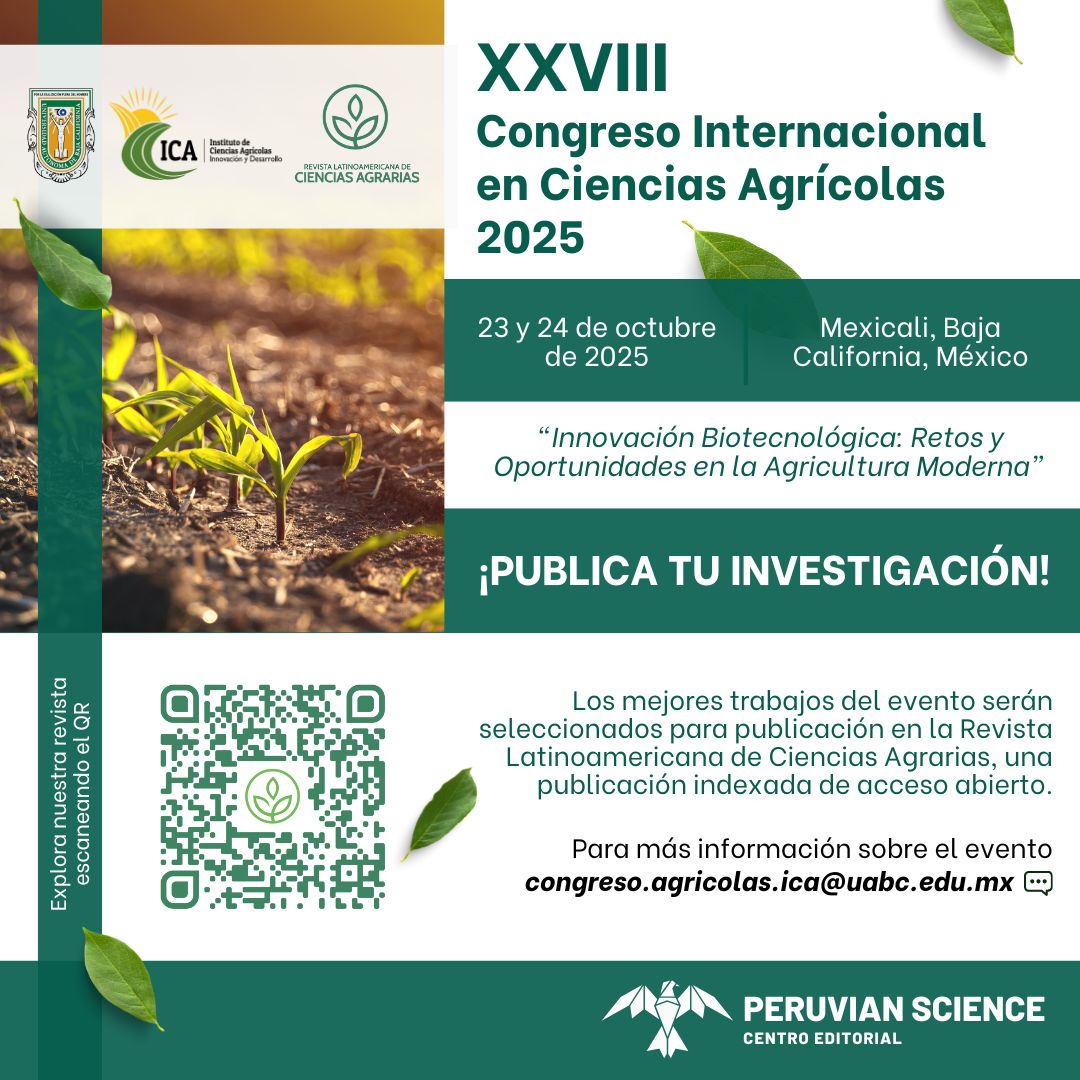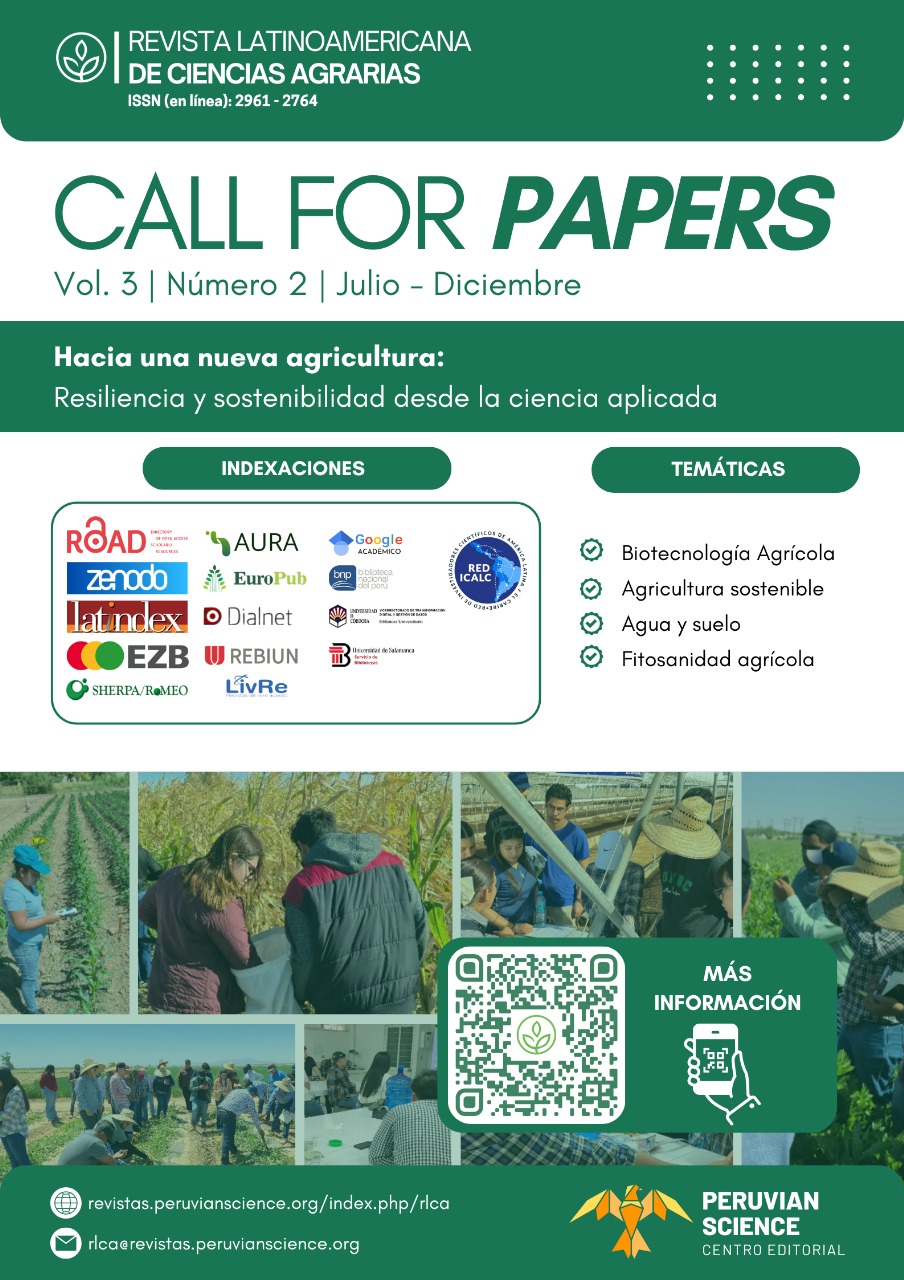Congreso Internacional

Call For Papers

Normas para autores
Todos los artículos enviados dentro de los objetivos y políticas de la revista serán considerados para publicación. Los artículos centrados en el campo agrícola deberán ser de interés para una amplia audiencia y los métodos empleados dan como resultado una mejora sustancial sobre las técnicas y enfoques establecidos existentes. Los artículos sobre métodos son bienvenidos solo cuando la(s) técnica(s) descrita(s) es(n) novedosa(s) o proporciona un avance importante de los protocolos establecidos.
Instrucciones para autores
La instrucción del autor debe ser específica de la revista y, según el tema o los temas de interés de la revista, debe incluir potencialmente lo siguiente:
Información específica del ensayo. Los registros de ensayos aceptables incluyen los enumerados. Los autores de ensayos también deben presentar protocolos (incluido el plan de análisis estadístico completo).
Orientación sobre declaraciones para la aprobación ética de estudios en seres humanos, consentimiento, formularios de permiso del paciente (cuando los pacientes pueden ser identificables a partir del contenido).
Lista de las categorías de artículos que publica la revista (p. ej., reseñas, informes breves, investigación original, opiniones, cartas) y una descripción de cada tipo que incluya el número máximo de palabras, número de figuras/tablas, estilo de resumen (estructurado o no estructurado) y qué secciones incluye cada artículo.
Se debe incluir el número de referencias. Puede ser útil, cuando los recursos lo permitan, incluir enlaces a varios artículos de libre acceso como ejemplos de cada estilo de artículo, lo que puede ayudar a los autores a hacerlo bien la primera vez.
Estructura del artículo: Organizar la información mediante un resumen que sintetice el tema a desarrollar complementando con palabras clave y su contraparte en inglés. Proseguir con la sección introductoria en la que se describa la realidad problemática, objetivos y aspectos relacionados con la importancia del estudio. Posteriormente, desarrollar la fundamentación teórica de acuerdo con los criterios establecidos en la operacionalización de las variables y finalmente, describir la metodología aplicada durante la ejecución de la investigación.
Resultados y Discusión: Se presentará en una o dos secciones, según el interés del autor. Los resultados podrán reportarse por medio de tablas y figuras que se insertarán en el texto después del párrafo en que se mencionen por primera vez. Deben numerarse consecutivamente de acuerdo con el orden en que se citan. Las cifras no deben duplicar los datos de las tablas. Si se incluye un gráfico, debe tener una estructura simple y ser fácil de entender. En la Discusión se deberán explicar de forma clara, precisa y directa los resultados obtenidos y se enuncian los mecanismos biológicos, así como sus posibles efectos en relación con los resultados. Serán respaldados por las correspondientes referencias actualizadas.
Conclusión: Debe hacer referencia a las síntesis del trabajo previamente realizado acordes a los objetivos de la investigación.
Referencias: Se escribirán al final del trabajo y se ordenarán alfabéticamente según el apellido del primer autor. En caso de coincidir el primer autor, se debe utilizar el segundo autor y así sucesivamente. Es obligatorio el uso de un gestor de referencias.
Extensión del papel: No debe exceder las 12 - 15 hojas.
Redacción: Utilizar un lenguaje claro, directo y preciso. Evitar el uso indebido de gerundios, tiempos compuestos, adjetivos calificativos y otros términos no reconocidos en el lenguaje científico como neologismos, anglicismos y vocablos regionales. No utilice frases largas.
Tablas: Deben tener el menor número posible de filas y columnas. No se deben de utilizar abreviaturas para los tratamientos, sino una descripción simple de los mismos (por ejemplo, no escriba Tratamiento A, B, sino control y 100 kg de N, respectivamente). Los valores promedio deben ir acompañados de las estadísticas correspondientes, el error estándar y la significancia. Si se utilizan transformaciones, debe aparecer el valor transformado y el valor original debe incluirse entre paréntesis. Deben usarse letras como superíndices para mostrar las diferencias entre las medias y la prueba de comparación utilizada debe anotarse en la parte inferior de la tabla. Debe indicarse el valor de probabilidad exacto (P). El número en el orden de la tabla y su título deben aparecer en la parte superior de la tabla. Las tablas de análisis de varianza sólo serán aceptadas en los casos requeridos para la interpretación de los resultados.
Figuras: Deben contener el menor número posible de curvas. Los datos de la tabla no deben repetirse. Cuando se reportan regresiones, se deben denotar los puntos de dispersión y se debe incluir la ecuación con sus términos, error estándar, coeficiente de determinación y su significado. El procedimiento será el mismo para los modelos. Se debe utilizar una escala adecuada. Se debe anexar una tabla de valores al papel para reproducir la figura. El número en el orden de la figura y su título deben escribirse al pie de la figura. Se utilizarán símbolos para diferenciarlos (cuadrados, triángulos, círculos). No se aceptarán figuras con formato de imagen.
Diagramas: Sólo se aceptarán en los casos en que sean necesarios para la comprensión del procedimiento o de los resultados. En el caso de diagramas no clásicos, el autor deberá adjuntar una explicación.
Nomenclatura: Las referencias a los títulos de los trabajos y la primera mención a especies animales y vegetales (excepto animales domésticos o cultivos) en el título o dentro del resumen o cuerpo del trabajo se darán por sus nombres científicos, seguidos del nombre del autor. Los nombres de los autores deben citarse completos, con excepción de Linneaeus (L) y Fabricius (F), de acuerdo con los Códigos Internacionales de Nomenclatura Zoológica y Botánica. También pueden incluirse nombres comunes, si se usan internacionalmente. Las especies pueden citarse por su nombre genérico cuando no se menciona otra especie del mismo género en el artículo. En tal caso, se puede utilizar la inicial del nombre genérico y el nombre específico completo (p. ej., L. leucocephala). Los nombres científicos de animales, plantas y microorganismos, así como las palabras en latín, deben escribirse siempre en cursiva (p. ej., Leucaena leucocephala, Heteropsylla cubana, Lactobacillus rhamnosus, in vitro e in vivo).
Referencias: Este es uno de los indicadores de calidad de un trabajo de investigación. Deben actualizarse y la mayor cantidad de ellos debe usarse en la sección de Discusión. Pueden ser tomados de revistas científicas, libros, tesis, congresos, simposios y documentos electrónicos. En el texto se recomienda la menor cantidad de auto citas, así como las de la misma publicación. La revista no aceptará referencias de comunicaciones personales, datos inéditos, citas referidas, informes técnicos, informes de proyectos o de publicaciones no científicas.
Cuando se acerque a los árbitros, es una buena práctica invitarlos antes de enviar el manuscrito completo. La comunicación debe contener los siguientes elementos:
Las decisiones de los revisores son realmente solo recomendaciones y tienden a caer en las siguientes categorías:
La decisión no debe basarse en una encuesta de cuántos acepta, rechaza y quizás dieron los revisores. Como editor, debe verificar lo que han sugerido los revisores y tomar la decisión final. A veces, los comentarios de los revisores pueden ser muy superficiales y ocasionalmente inapropiados.
Plantilla del Artículo (Descargar)
Rol del autor de correspondencia
Se asigna un autor como autor correspondiente y actúa en nombre de todos los coautores y garantiza que las preguntas relacionadas con la precisión o integridad de cualquier parte del trabajo se aborden adecuadamente.
El Autor de Correspondencia es responsable de los siguientes requisitos:
Identificación del autor
Se recomienda encarecidamente a los autores que utilicen su ORCID ID cuando envíen un artículo para su consideración o adquieran una ORCID ID a través del proceso de envío.
Congreso Internacional

Call For Papers

Video
©CENTRO EDITORIAL PERUVIAN SCIENCE S.A.C.
Urb. Santa Fe de Naranjal, San Martin de Porres, Lima - Perú
ISSN: 2961-2764 (En línea)
Contacto: 942723906